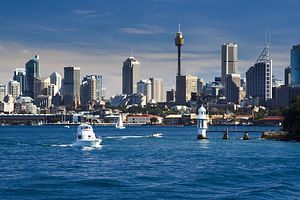A day after Australians learned that their educational rankings were falling relative to Asia, the national statistician reported subpar economic growth figures. For the recently elected Abbott government, life after the mining boom isn’t getting any easier.
Disappointing economists and the government, on Wednesday the Australian Bureau of Statistics (ABS) announced that gross domestic product (GDP) expanded by 0.6 percent in the third quarter compared to the previous three months, below market forecasts of a 0.7 percent gain.
On an annualized basis, the world’s 12th largest economy grew by 2.3 percent from a year earlier, below economists’ anticipated 2.6 percent expansion and also short of the federal Treasury’s pre-election forecast.
Lower commodity prices hit Australia’s national income, with the nation’s terms of trade diving by 3.3 percent for the quarter, down nearly 18 percent from their 2011 peak. Household consumption expanded by a subdued 0.4 percent, while gross national expenditure fell by 0.1 percent.
The Australian dollar dropped to a three-month low below US$0.91 on the news, although the local share market shrugged off the weaker data.
In a research note, ANZ senior economist Felicity Emmett said the major surprise was weaker than expected business investment, including new engineering construction.
“Today’s numbers combined with more up-to-date information on the economy suggest that growth remains below trend, although there are some positive signs emerging. While the windback in mining investment expected over the next couple of years will weigh on growth, there are some early signs that other sectors of the economy are starting to pick up,” Emmett said.
The economist said the latest data appeared to be “broadly in line” with the Reserve Bank of Australia’s (RBA’s) forecasts, which on Tuesday left the nation’s official interest rate at an historic low of 2.5 percent. The central bank’s last policy change was in August, when it lowered the cash rate by 0.25 percentage point.
The RBA’s official statement noted slower than normal world growth had hit the Australian economy, which was adjusting to lower levels of mining investment.
“Further ahead, private demand outside the mining sector is expected to increase at a faster pace, though considerable uncertainty surrounds this outlook. There has been an improvement in indicators of household and business sentiment recently, but it is still unclear how persistent this will be,” RBA governor Glenn Stevens said.
The central bank’s “jawboning” campaign against the local currency has continued, with the governor warning that the Australian dollar remained “uncomfortably high” and that a weaker exchange rate was required to achieve balanced growth.
The RBA has cut official interest rates by 2.25 percentage point since November 2011 amid the post-mining boom slowdown and a weaker world economy, with the aim of stimulating non-mining sectors such as manufacturing and property. But while the Sydney housing market has surged, the rest of the nation has yet to join the party, as noted previously by The Diplomat.
Commenting on the GDP data, Australian Treasurer Joe Hockey said the economy had been growing at a “sub-trend” pace below 3 percent for four straight quarters, due to a “soft labor market, cautious consumers and plateauing business investment”.
“Combined with other economic data it is clear that the nominal growth forecasts in the [Pre-Election Economic and Fiscal Outlook] will not be reached. This points towards a further deterioration in the budget bottom line,” he warned.
The center-right Coalition government has faced a number of early policy tests, ranging from subsidies for local automakers to support for the national flag carrier, Qantas. The prime minister’s “open for business” pledge also came under fire after blocking a U.S. takeover for grains handler GrainCorp.
The government’s moves to improve the nation’s finances have also been damaged by a row over education spending, which forced Prime Minister Tony Abbott to pledge another A$1.2 billion for Australian schools.
Asia Leading Educational Race
Australia’s prospects of developing a knowledge-based economy have been dented by a new report showing the nation lagging behind its major trading partners in Asia.
A report released Tuesday by the Organisation for Economic Co-operation and Development (OECD) on international educational achievement showed Asian nations outperforming the rest of the world in mathematics, reading and science, with Australia slipping behind.
“Shanghai-China, and Singapore were top in maths, with students in Shanghai scoring the equivalent of nearly three years of schooling above most OECD countries. Hong Kong-China, Chinese Taipei, Korea, Macao-China, Japan, Liechtenstein, Switzerland and the Netherlands were also in the group of top-performing countries,” the OECD said.
The latest Programme for International Student Assessment (PISA) tests of the world’s 15-year-olds found that Australian students were three years behind Shanghai students in math and 1.5 years behind in reading.
As the OECD’s secretary general Angel Gurria noted, “In a global economy, competitiveness and future job prospects will depend on what people can do with what they know.”
Having been quickly schooled in the realities of government, the Coalition will be hoping that the economy’s rebalancing happens sooner rather than later for its fiscal report card.

































